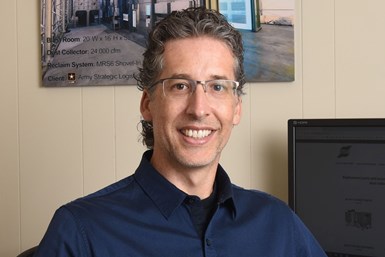An Interview With Brandon Acker, Titan Abrasive Systems
Blasting plays an important surface preparation for coating operations. Brandon Acker, president of Titan Abrasive Systems, offers insights for blasting best practices, common pitfalls and more.
Edited by Scott Francis

Brandon Acker, president, Titan Abrasive Systems.
Photo Credit: Titan Abrasive Systems
Brandon Acker is president of Titan Abrasive Systems (Warminster, Pa.), a manufacturer of media blasting equipment and custom-engineered blast rooms that has been a provider of American-made blasting solutions since 1953. From modest beginnings, the company has grown over the years to include aerospace and military customers. Today, Titan remains a factory direct company and takes pride in working closely with its customers. In this interview, Acker offers insights for blasting best practices, common pitfalls and more.
Can you give us a little bit of background about how you came into your role at Titan?
Featured Content
It always has been a family company. My uncle started it back in 1953. And I've always been involved, you know, building blocks and building valves for blast machines, since I was a little kid. And it's just grown. I was always working with the company. I had the opportunity later in life in 2013, to take over. That allowed me to take it into a little bit different direction and grow the business as I thought it should be and could be. It's helped us and taken us to a new level.
Obviously, blasting plays an important role for coaters and finishers — and I think most finishers are familiar with it as a way to prepare surfaces prior to finishing processes. But can you talk about the importance of good blasting practices in achieving a quality end finish?
An extremely important part of any coating is the surface preparation, and abrasive blasting is one of the go-to methods — and one of the safest and fastest methods. Between 60-85% of all premature coating failures can be directly linked to inadequate surface preparation. That’s a very large number and speaks to the benefits and the need for proper surface preparation.
If you put a coating on a smooth surface, it’s not going to adhere. Blasting creates what is called an anchor pattern — a lot of little peaks and valleys on the metal that allow the coating to grip on.
Can you talk a little bit about selecting the right kind of blasting media for an application?
There are a lot of media out there — much more than there used to be. Disposable media includes sand and coal slag. Then you have your reclaimable media such as steel grit, steel shot, aluminum oxide and garnet.
Choosing the right media is important depending on what that product is you’re trying to blast. Take, for example, the differences between steel grit and steel shot. They’re both steel media, one is angular, one is round. They’re going to give you a completely different result. The angular grit is going to cut into the substrate and give you the profile for coating to adhere to. Steel shot is just going to clean a surface, but it’s not going to give you any profile, so you wouldn’t use it if you're looking to have coating adhere to a metal surface. Similarly, with glass media, there’s crushed glass and glass bead. Crushed glass is angular and will give you more of a profile.
What are some common mistakes or misconceptions that people have regarding blasting processes?
A big misconception is that blast rooms are messy. It’s all about housekeeping. If you have a dust collection system, you put the room under negative pressure, it’s going to maintain that keep that dust and debris inside. As long as you’re not opening the doors while you’re blasting, opening them too early before the dust collector has cleared the room, or tracking debris in and out of the room, the blast room is not going to fill your shop with dust.
Another thing to pay attention to is maintenance. Maintenance on blasting equipment is pretty intense — it’s the nature of the beast. Think about what that abrasive does to a product — what it does to steel and how it removes old coatings. It also does the same thing to your equipment, unfortunately. There are parts on the equipment that do wear — you need to pay attention to those areas. Make sure to check valves and consumables that can be replaced easily.
Also, make sure to keep the air dry. Moisture is not your friend when you blast. It will cause the media to clump, which can clog the equipment. You want to make sure you have really clean, dry air. That will give you the best results.
Could you speak to some quality issues that can arise if blasting is done incorrectly?
Probably the biggest issue with blasting is not having that proper profile and having coating failure. If you’re using the wrong media or too much pressure, you can create too much profile. In that case, it can take a lot of coating to cover the profile and you can get jagged peaks in the coating. You can also have too little profile, in which case your coating will not adhere properly. Nobody wants a coating failure.
Listen to the complete interview with Brandon Acker in an episode of our On the Line podcast. Visit short.pfonline.com/OTL19.
RELATED CONTENT
-
Chemically Accelerated Vibratory Surface Finishing (CAVSF) with Oxalic Acid-Based Solutions
It has been shown that the inexpensive chemically accelerated vibratory surface finishing (CAVSF) process can reduce the average surface roughness.
-
Super Finish
How to achieve an isotropic finish using a traditional vibratory bowl—and why you’d want to do it
-
What’s in a Burr?
An unclear definition has led to an industry standard for classifying burrs.



















